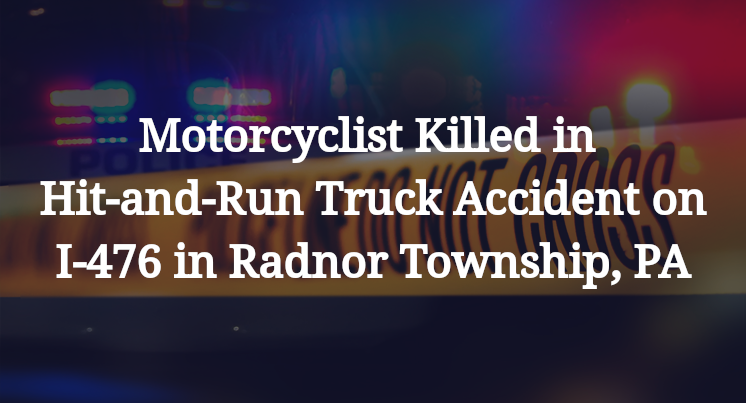Motorcyclist Killed in Hit-and-Run Truck Accident on I-476 in Radnor Township, PA
Delaware County, PA — May 22, 2025, a motorcyclist was killed in a hit-and-run truck accident at about 4:45 p.m. on northbound Interstate 476.
Authorities said a motorcyclist lost control near Exit 13 in Radnor Township and slid across several lanes of traffic before being hit by a white box truck. The truck did not stop after the collision.

The motorcyclist, whose name has not been made public, died at the scene of the crash, according to authorities.
Authorities have not released any additional information about the Delaware County crash at this time. The accident is still being investigated.
Commentary
When news breaks that a motorcyclist was killed by a hit-and-run truck driver, most folks understandably want answers: How did this happen? Why would a driver flee the scene? And what steps are investigators taking to find out?
But from a legal perspective, there are even more pressing questions beneath the surface, questions that don’t get answered unless someone makes it their business to dig into the evidence. And in my experience, the truth in these cases often depends on getting access to data most people don’t even know exists.
According to reports, the motorcyclist lost control on I-476 and was then struck by a white box truck that didn’t stop. But that’s not the whole story. In fact, it raises more questions than it answers.
- What caused the motorcyclist to lose control in the first place? Was it road debris, another vehicle cutting them off or possibly a mechanical issue? None of that is clear right now.
- Was the truck driver already nearby when the motorcyclist slid into the lane, or did the truck come up afterward? Depending on the timing, different responsibilities apply.
- And most importantly: Why did the truck driver flee? Was the driver even aware they struck someone? Or did they know and choose to keep going anyway?
These aren't questions that can be answered with a press release or a police report summary. They require physical evidence—dash cams, cell phone records, engine control module ("black box") data and possibly eyewitness testimony. Without that, we’re just left with speculation.
Hit-and-run crashes involving commercial vehicles present a unique investigative challenge. Unlike regular passenger cars, commercial trucks usually have:
- GPS tracking systems, which can narrow down location and travel time;
- Dash cameras, which may show exactly what the driver saw;
- Driver logs, which might reveal inconsistencies that suggest a crash occurred.
These are tools law enforcement can request, but they’re also key pieces of evidence in civil investigations. I’ve worked on several cases where a trucking company initially claimed not to know who was driving a vehicle involved in a crash, until we subpoenaed their dispatch records and uncovered the truth.
In some hit-and-run cases, companies try to deny responsibility by claiming the driver went “off route” or wasn’t authorized to be driving. That doesn’t always hold up in court, but it’s a defense we’ve seen before. Without knowing who owned the truck, who was operating it and whether the driver was on the job, it’s impossible to fully assess who might ultimately be liable here.
Too often, the public accepts a crash report at face value without realizing how much is left out. Even when a motorcyclist “loses control,” that doesn't automatically absolve others of fault, especially when a commercial vehicle is involved and leaves the scene.
To get accountability, someone has to press for the facts: identify the vehicle, determine what the driver was doing and find out whether company policies or mechanical issues played a role. That’s the only way to ensure the right people are held responsible, not just the most convenient target.
Key Takeaways
- Reports say the motorcyclist “lost control,” but the cause of that remains unknown and uninvestigated in public reports.
- The truck’s failure to stop raises serious legal and ethical questions, especially if it was a commercial vehicle with tracking or camera systems.
- Identifying the truck and driver is essential; so is investigating ownership, driver status and company oversight.
- Dash cams, black box data and dispatch logs can be critical in piecing together how the crash unfolded.
- Responsibility can't be assigned until a full investigation determines who did what, and who should have acted differently.

“These are essential reads for anyone dealing with the aftermath of a truck wreck”– Attorney Cory Carlson